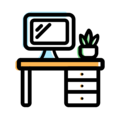
Working from home is no small feat, especially when you are used to operating out of an office setting. COVID-19 has the office views looking a little different these days, but we are still hard at work on the home front taking our clients' websites and digital marketing to the nines. We learned very quickly that working remotely doesn't mean that you have to sacrifice productivity. We've compiled the following guide to help make the transition easier for you and your team. Now is the time to establish rhythms that keep both your mental and physical health at the forefront. While implementing one or two of these may be somewhat helpful, we highly recommend using them all in your personal routine. Think of this list as the ultimate formula for productivity. Without further ado, here are nine ways you can stay productive while working remotely.

1. Keep your morning routine.
Working remotely means that you could easily find yourself still in your pajamas at 3 p.m. While it is possible to get work done in your favorite pair of sweatpants, there’s just something about putting “real” pants on that tells your brain, “Hey buddy, it’s time to get to work.” Just because you are working from home doesn’t mean that you should abandon your morning routine. Get up at the time you normally would if you were headed to the office. Do you typically exercise before going to work? Do an at-home workout in your garage. Do you typically spend time meditating or reading scripture in the morning? Do it! Get up. Get dressed. Seize the day.

2. Communicate!
If communication was key before, it is now the passcode preventing your business from self-destruction. While face-to-face communication is out of the question for now, there are a plethora of ways you can maintain efficient and effective communication with your team.
Email is your friend.Google Workspace offers user-friendly collaboration and productivity apps for businesses. You can set up shared calendars, schedule and invite team members to virtual team meetings using Google Meet, save and share files, and simultaneously work on collaborative projects using Google Drive. All you need is a Gmail account.
Video Meetings are the new conference room. Zoom is a virtual meeting platform that allows as many people to meet as necessary. One cool feature allows the host to send members of the meeting to virtual “breakout rooms.” This is great if your team needs to communicate about department or project-specific items. There are free and premium options available. The free version only allows you to meet for 40 minutes at a time, so keep this in mind.
Slack is now your office. Slack is an instant messaging platform that allows you to communicate with your team quickly and easily. You can create different channels for different departments and projects, as well as share files.

3. Create a designated workspace.
As tempting as it is to sit in your bed with your laptop in your lap and a bag of chips by your side, creating a designated workspace will help ensure that there is no work-time/nap-time crossover. Don’t worry, you can bring the chips. If you don’t have a formal office in your living space, find a spot to claim as your own. It can be a designated seat at your kitchen table or the sofa with a TV-dinner-tray desk. Just stay consistent. This should be an environment that encourages productivity. Again, it’s all about creating that “time to work” mentality.

4. Take breaks!
Taking breaks is not counterproductive. In fact, giving yourself time to step away from your work will actually increase your productivity. We recommend taking five minutes at the end of every hour to breathe and enjoying a longer lunch break around noon. Take a lap around your neighborhood or several around your house. Dedicate your break to silence and solitude or coffee and contemplation. How you spend your breaks is up to you, but it’s crucial to maintaining motivation and mental clarity during your work day.

5. Limit personal screen time.
Working remotely means that your screen time during the workday will increase significantly. When you’re not working, seek out screenless alternatives to give your eyeballs a break. Read a book. Try a new recipe. Do an at-home workout. Call a friend. Clean out your closet. Take a 26 minute nap. Embark on one of those 1000-piece puzzles with your family. Play a board game. Host a dance party. Learn a new song on the guitar. Excessive screen time can have detrimental effects on your mental health. This is the perfect time to check off some of those more low key bucket list items.

6. Fuel your body.
Reminding you to eat and hydrate may seem ridiculous, but working from home can lead you to neglect your body’s most basic needs. When 5 o’clock rolls around, you’re likely to find yourself finishing off your fourth sleeve of Double Stuf Oreos, or having gone the whole day without eating anything at all. Not good. Consider “packing” a lunch and snacks as you would if you were headed to the office. Set an alarm to remind yourself when it’s time to eat. Perhaps avoid buying the BOGO Oreos at Publix on your next grocery run. Everyone’s dietary needs and relationships with food are different, which is why creating a simple, customized plan for yourself is important to ensuring that you’re fueling your body properly.
It is equally, if not more so, important to keep yourself hydrated. No, energy drinks don’t count. Instead of sprinting towards the coffee pot first thing in the morning, grab your favorite mug and fill it with water. Tell yourself you can’t have coffee until you’ve finished off one or two mugs of water. Repeat this process for every cup of coffee you drink throughout the day.

7. Make a game plan for your work day.
If it hasn't happened already since you started working from home, there will likely come a point when you will get to 5 o’clock and think, “What did I even do today?” Spend 15-20 minutes at the end of every work day mapping out a game plan for the next day. Write out specific goals and a list of prioritized tasks. That way, when you sit down at your designated work space the next morning, you know exactly what you need to accomplish.

8. Practice mindfulness.
Increased screen time and cabin fever are the perfect recipe for mental fog. Taking intentional measures to clear your mind throughout the day is crucial for maintaining mental clarity… and your sanity. Journal for five to ten minutes at the beginning and end of your work day. Put your thoughts on paper. Write out how you’re feeling, what you’re worried about, and what you can choose to celebrate. Take prayer walks. Meditate. Breathe.

9. Set boundaries.
This is probably the most important step you can take. Define your work day by setting a designated start and finish time. These times should mimic your typical workday in the office. Once it’s time to go home, or in this case, leave your workspace, do not touch your work again until the next day. Working from home can lead to unhealthy work-life imbalances that are detrimental to your productivity, mental health, and relationships with your loved ones. Work when it’s time to work. Rest when it’s time to rest.
Working from home and practicing social distancing doesn't mean you have to sacrifice productivity.
